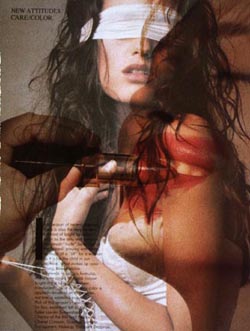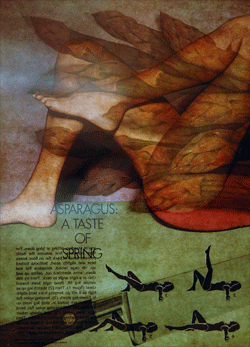Robert Heinecken 1932-2006: Sex and food, a memorial exhibition

About the Exhibition
In honor of Robert Heinecken’s crucial contributions to the world of fine art photography, the Museum of Contemporary Photography will mount an exhibition of selected projects—magazine alterations, a satire on fashion photography, and some rarely seen Polaroid photograms using perishable food.
Beginning in the late 1960s and continuing to the late 1990s, Robert Heinecken produced a series of projects that involved manipulating and recombining media imagery in order to understand how this imagery, chiefly photographic, works on and through our imaginations. A short list of thinkers, writers and artists in his frame of reference would be Marshall McCluhan, Marcel Duchamp, Andre Breton, Alain Robbe-Grillet, Ed Ruscha, Robert Rauschenberg, Wallace Berman. Early on, Heinecken worked solidly within a practice we now identify as Post-Modernist: appropriation, deconstruction, relinquishment of authorial control, subverting traditional art exhibition and distribution practices, etc. To a large degree he invented this practice before it was named. One of the elements of this practice—that most of what we now experience is highly sophisticated simulation—sits strangely on the shoulders of a former Marine jet fighter pilot, whose life depended on his real time perception of real things.
Because of his persona and history, it took the art world a while to understand that he was profoundly intellectual. He wrote and gave conference papers on19th century photography, and the effects of manipulating photographs on our confidence in what we see in general. He was first and foremost interested in co-opting the strategies of a system designed to dumb us down—advertising and news media—in order to make ideas visible that could smarten us up. This takes both intellectual courage and the ability to run headlong into enemy territory.
Heinecken thought of the use of sex in mass media not as a spectrum from fashion to pornography, but a continuum. He was most interested in porn strategies used by the fashion industry, and can be thought of as trying to make this transparent. His use of demeaning imagery of women in pornography was occasionally hard to reconcile with his sincere feminist position, but not with his habit of pushing limits imposed by others. This caused him to be ostracized during the politically correct 1980s and early 90s. His response was to ask, and explore, why women are attracted to female poses in fashion magazines that utilize the conventions of pornography.
Paul Berger, a student of Heinecken’s at UCLA in the late 1960s, points out that Heinecken’s work, “is a simple, direct and unlockable doorway into the mass media image world—a world carefully constructed to disguise its inner workings and keep us outside of these workings—on the surface.” Where, it might be added, we have been taught to make decisions without thinking.
—Rod Slemmons, from Recto/Verso, Nazraeli Press, 2006
Robert Heinecken was born in Denver, Colorado on October 29, 1931. He began his education at Riverside Junior College in Riverside, California (1949-1951), was a fighter pilot in the U.S. Marine Corp from 1953-1957, and went on to study art at the University of California, Los Angeles, earning a BA (1959) and then an MA (1960). In 1964 he founded the graduate program for photography at UCLA, and retired from the institution in 1991. He was a member of the Board of Trustees of The Friends of Photography and a chairman of the Society for Photographic Education. He received a Guggenheim Fellowship (1976), a National Endowment for the Arts Individual Artists Grant (1977, 1981, 1986), and Polaroid Corporation grants to use 20×24 and 40×80 cameras (1984, 1985, 1988). Since 1964, Heinecken has had over sixty one-person shows internationally including: the Center for Creative Photography, University of Arizona, Tucson, and a 35-year retrospective exhibition at the Museum of Contemporary Art, Chicago in 1998. His work is in the collections of such institutions as the George Eastman House and Mills College Art Gallery.
Image Gallery

